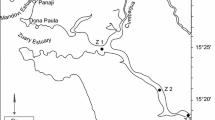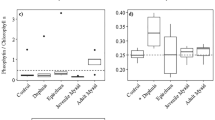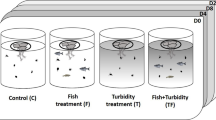Abstract
The impact of mesozooplankton (>210 μm, mostly adult copepods and late-stage copepodites) and micrometazoa (64–210 μm, mostly copepod nauplii) on phytoplankton size structure and biomass in the lower Hudson River estuary was investigated using various14C-labeled algal species as tracers of grazing on natural phytoplankton. During spring and summer, zooplankton grazing pressure, defined as %=mg C ingested m−2 h−1/mg C produced m−2 h−1 (depth-integrated rates)×100, on total phytoplankton ranged between 0.04% and 1.9% for mesozooplankton and 0.1% and 6.6% for micrometazoa. The greatest grazing impact was measured in fall when 20.2% and 44.6%, respectively, of the total depth-integrated primary production from surface water phytoplankton was grazed. Mesozooplankton exhibited some size-selective grazing on phytoplankton, preferentially grazing the diatomThalassiosira pseudonana over the larger diatomDitylum brightwelli, but this was not found for micrometazoa. Neither zooplankton group grazed on the dinoflagellateAmphidinium sp. We conclude that metazoan zooplankton have a minimal role in controlling total phytoplankton biomass in the lower Hudson River estuary. Differences in the growth coefficients of various phytoplankton size-fractions—not grazing selectivity—may be the predominant factor explaining community size-structure.
Similar content being viewed by others
Literature Cited
Allan, J. D., S. Richman, D. R. Heinle, andR. Huff. 1977. Grazing in juvenile stages of some estuarine calanoid copepods.Marine Biology 43:317–331.
Bellantoni, D. C. andW. T. Peterson. 1987. Temporal variability in egg production rates ofAcartia tonsa Dana in Long Island Sound.Journal Experimental Marine Biology and Ecology 107:199–208.
Berquist, A. M., S. R. Carpenter, andJ. C. Latino. 1985. Shifts in phytoplankton size structure and community composition during grazing by contrasting zooplankton assemblages.Limnology and Oceanography 30:1037–1045.
Capriulo, G. M. andE. J. Carpenter. 1980. Grazing by 35 to 202 μm microzooplankton in Long Island Sound.Marine Biology 56:319–326.
Chervin, M. B. 1978. Assimilation of particulate organic carbon by estuarine and coastal copepods.Marine Biology 49:265–275.
Chervin, M. B., T. C. Malone, andP. J. Neale. 1981. Interactions between suspended organic matter and copepod grazing in the plume of the Hudson River.Estuarine, Coastal and Shelf Science 13:169–183.
Conover, S. A. M. 1956. Oceanography of Long Island Sound, 1952–1954. IV. Phytoplankton.Bulletin of the Bingham Oceanographic Collection 15:62–112.
Cosper, E. M., B. J. Snyder, L. M. Arnold, L. A. Zaikowski, andC. F. Wurster. 1987. Induced resistance to polychlornated biphenyls confers cross-resistance and altered environmental fitness in a marine diatom.Marine Environmental Research 23: 207–222.
Dagg, M. 1977. Some effects of patchy food environments on copepods.Limnology and Oceanography 22:99–107.
Dam, H. B. 1986. Short-term feeding ofTemora longicornis Muller in the laboratory and the field.Journal of Experimental Marine Biology and Ecology 99:149–161.
Daro, H. M. 1978. A simplified14C method for grazing measurements on natural planktonic populations.Helgolander Wissenschaftliche Meeresunters 31:241–248.
Durbin, E. G., A. G. Durbin, andR. G. Campbell. 1992. Body size and egg production in the marine copepodAcartia hudsonica during a winter-spring diatom bloom in Narragansett Bay.Limnology and Oceanography 37:342–360.
Durbin, E. G., A. G. Durbin, T. J. Smayda, andP. G. Verity. 1983. Food limitation of production by adultAcartia tonsa in Narragansett Bay, Rhode Island.Limnology and Oceanography 28:1199–1213.
Findlay, S., M. L. Pace, D. Lints, J. J. Cole, N. F. Caraco, andB. Peierls. 1991. Weak coupling of bacterial and algal production in a heterotrophic ecosystem: The Hudson River estuary.Limnology and Oceanography 36:268–278.
Frost, B. W. 1980. Grazing, p. 465–491.In I. Morris (ed.), The Physiological Ecology of Phytoplankton. Blackwell Scientific, Cambridge, Massachusetts.
Gallager, S. M., D. K. Stoecker, andV. M. Bricelj. 1989. Effects of the brown tide alga on growth, feeding physiology and locomotory behavior of scallop larvae (Argopecten irradians), p. 511–541.In E. M. Cosper, V. M. Bricelj, and E. J. Carpenter (eds.), Novel Phytoplankton Blooms: Causes and Impacts of Recurrent Brown Tides and Other Unusual Blooms. Volume 35. Springer-Verlag, Berlin.
Gifford, D. J. andM. J. Dagg. 1991. The microzooplankton-mesozooplankton link: Consumption of planktonic protozoa by the calanoid copepodsAcartia tonsa Dana andNeocalanus plumchrus Murukawa.Marine Microbial Food Webs 5:161–177.
Guillard, R. R. L. andJ. H. Ryther. 1962. Studies of marine planktonic diatoms. I.Cyclotella nana Hustedt, andDetonula confervacea (Cleve) Gran.Canadian Journal of Microbiology 8: 229–239.
Haney, J. F. 1971. An in situ method for the measurement of zooplankton grazing rates.Limnology and Oceanography 16: 970–977.
Houde, S. E. L. andM. R. Roman. 1987. Effects of food quality on the functional ingestion response of the copepodAcartia tonsa.Marine Ecology Progress Series 40:69–77.
Huntley, M. E. 1982. Yellow water in La Jolla Bay, California, July 1980. II. Suppression of zooplankton grazing.Journal of Experimental Marine Biology and Ecology 64:81–91.
Huntley, M. E. andM. P. G. Lopez. 1992. Temperature-dependent production of marine copepods: A global synthesis.American Naturalist 140:201–242.
Jonasdottir, S. H. 1992. Chemical composition of food and the reproductive success of the copepodsAcartia tonsa, Acartia hudsonica andTemora longicornis. Ph.D. Dissertation, State University of New York at Stony Brook, New York.
Jonasdottir, S. H. 1994. Effects of food quality on the reproductive success ofAcartia tonsa andAcartia hudsonica: Laboratory observations.Marine Biology 121, Part 1:67–81.
Kerfoot, W. C., C. Levitan, andW. R. DeMott. 1988.Daphnia-phytoplankton interactions: Density-dependent shifts in resource quality.Ecology 69:1806–1825.
Kim, W.-S. 1993. Zooplankton community effects on the phytoplankton community in Long Island bays. Ph.D. Dissertation, State University of New York at Stony Brook, New York.
Kiorboe, T., F. Mohlenber, andK. Hamburger. 1985. Bioenergetics of the planktonic copepodAcartia tonsa: Relation between feeding, egg production and respiration, and composition of specific dynamic action.Marine Ecology Progress Series 26:85–97.
Kleppel, G. S. 1992. Environmental regulation of feeding and egg production byAcartia tonsa off southern California.Marine Biology 112:57–65.
Kleppel, G. S. 1993. On the diets of calanoid copepods.Marine Ecology Progress Series 99:183–195.
Kleppel, G. S., D. V. Holliday, andR. E. Peiper. 1991. Trophic interactions between copepods and microplankton: A question about the role of diatoms.Limnology and Oceanography 36: 172–178.
Lampert, W., W. Fleckner, H. Rae, andB. E. Taylor. 1986. Phytoplankton control by grazing zooplankton: A study on the spring clear-water phase.Limnology and Oceanography 31: 478–490.
Lampert, W. andB. E. Taylor. 1985. Zooplankton grazing in a eutrophic lake: Implications of diel vertical migration.Ecology 66:68–82.
Lonsdale, D. J., E. H. Cooper, W.-S. Kim, M. Doall, A. Dioadeenam, andS. H. Jonasdottir. 1996. Food web interactions in the plankton of Long Island bays, with preliminary observations on brown tide effects.Marine Ecology Progress Series 134: 247–263.
Lonsdale, D. J. and E. M. Cosper. 1994. Phytoplankton productivity and zooplankton feeding and productivity in the lower Hudson River estuary. Final Report to the Hudson River Foundation, New York.
Lonsdale, D. J. andB. C. Coull. 1977. Composition and seasonality of zooplankton of North Inlet, South Carolina.Chesapeake Science 18:272–283.
Lynch, M. 1978. Complex interactions between natural coexploiters—Daphnia andCeriodaphnia.Ecology 59:552–564.
Malej, A. andR. P. Harris. 1993. Inhibition of copepod grazing by diatom exudates: A factor in the development of mucus aggregates.Marine Ecology Progress Series 96:33–42.
Malone, T. C. 1977. Environmental regulation of phytoplankton productivity in the lower Hudson estuary.Estuarine, Coastal and Shelf Science 5:151–171.
Malone, T. C., C. Garside, andP. Neale. 1980b. Effects of silicate depletion on photosynthesis by diatoms in the plume of the Hudson River.Marine Biology 58:197–204.
Malone, T. C., P. J. Neale, andD. Boardman. 1980a. Influences of estuarine circulation on the distribution and biomass of phytoplankton size fractions, p. 249–262.In V. S. Kennedy (ed.), Estuarine Perspectives. Academic Press, New York.
Omori, M. andT. Ikeda. 1984. Methods in Marine Zooplankton Ecology. Wiley, New York.
Perissinotto, R. 1992. Mesozooplankton size-selectivity and grazing impact on the phytoplankton community of the Prince Edward Archipelago (Southern Ocean).Marine Ecology Progress Series 79:243–258.
Pierce, R. W. andJ. T. Turner. 1992. Ecology of planktonic ciliates in marine food webs.Reviews in Aquatic Sciences 6:139–181.
roman, M. R. and P. A. Rublee. 1981. A method to determine in situ zooplankton grazing rates on natural particle assemblages.Marine Biology 65:303–309.
Sokal, R. R. andF. J. Rohlf. 1981. Biometry. W. H. Freeman, San Francisco, California.
Stepien, J. C., T. C. Malone, andM. B. Chervin. 1981. Copepod communities in the estuary and coastal plume of the Hudson River.Estuarine, Coastal and Shelf Science 13:185–195.
Stoecker, D. K. andJ. M. Capuzzo. 1990. Predation on protozoa: Its importance to zooplankton.Journal of Plankton Research 12:891–908.
Strathmann, R. R. 1967. Estimating the organic carbon content of phytoplankton from cell volume or plasma volume.Limnology and Oceanography 12:411–418.
Strickland, J. D. and T. R. Parsons. 1972. A Practical Handbook of Seawater Analysis.Bulletin of the Fisheries Research Board of Canada. Bulletin 167.
Tackx, M. L. M. andM. H. Daro. 1993. Influence of size dependant14C uptake rates by phytoplankton cells in zooplankton grazing measurements.Cahiers de Biologie Marine 34:253–260.
Tantichodok, P. 1990. Relative importance of phytoplankton and organic detritus as food resources for the suspension-feeding bivalveMytilus edulis L. in Long Island Sound. Ph.D. Dissertation, State University of New York at Stony Brook, New York.
Tester, P. A. andJ. D. Turner. 1990. How long does it take copepods to make eggs?Journal of Experimental Marine Biology and Ecology 141:169–182.
Tester, P. A. and J. D. Turner. 1991. Why isAcartia tonsa restricted to estuarine habitats?, p. 603–611.In Proceedings of the Fourth International Conference on Copepoda, Karuizawa, Japan.Bulletin of the Plankton Society of Japan Special Vol. Higashi-Hiroshima, Japan.
Tilman, D. 1976. Ecological competition between planktonic algae: An experimental and theoretical approach.Ecology 58: 338–348.
Tilman, D., M. Mattson, andS. Langer. 1981. Competition and nutrient kinetics along a temperature gradient: An experimental test of a mechanistic approach to niche theory.Limnology and Oceanography 26:1020–1033.
Turner, J. T. 1982. The annual cycle of zooplankton in a Long Island Estuary.Estuaries 4:261–274.
Turner, J. T. 1984. Zooplankton feeding ecology: Contents of fecal pellets of the copepodsAcartia tonsa andLabidocera aestiva from continental shelf waters near the mouth of the Mississippi River.Pubblicaione Stazione Zoologica Napoli I.: Marine Ecology 5:265–282.
White, J. R. andM. R. Roman. 1992a. Egg production by the calanoid copepodAcartia tonsa in the mesohaline Chesapeake Bay: The importance of food resources and temperature.Marine Ecology Progress Series 86:239–249.
White, J. R. andM. R. Roman. 1992b. Seasonal study of grazing by metazoan zooplankton in the mesohaline Chesapeake Bay.Marine Ecology Progress Series 86:251–261.
Author information
Authors and Affiliations
Corresponding author
Rights and permissions
About this article
Cite this article
Lonsdale, D.J., Cosper, E.M. & Doall, M. Effects of zooplankton grazing on phytoplankton size-structure and biomass in the lower Hudson River estuary. Estuaries 19, 874–889 (1996). https://doi.org/10.2307/1352304
Received:
Accepted:
Issue Date:
DOI: https://doi.org/10.2307/1352304




